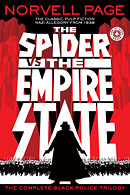John Newton Howitt
John Newton Howitt (1885-1958), a graduate of the Art Students League (other grads: Homer, Gibson, Pyle), started working professionally in 1907 as a painter of portraits, landscapes, and covers, and an illustrator of interior artwork for many “slick†magazines as well. Howitt had a parallel career as a fine artist, even exhibiting his work in major galleries in the 1920s. He produced a huge volume of work despite crippling polio for which he wore an iron brace on his right leg.
After the stock market crash of 1929, Howitt supplemented his work for the likes of The Saturday Evening Post and Country Gentleman (where he signed his full name) with work in the pulp field (where he signed his covers simply with an “H”). He painted for Top Notch, Adventure, Street & Smith Love Story, Clues, Detective Story and The Whisperer. For Popular Publications he created covers for Operator 5, Dime Detective, Horror Stories, and Terror Tales, as well as The Spider (beginning with the second issue in 1933, when he was 48). At his most prolific, he painted as many as seven pulp covers in a single month, and is estimated to have done over 300 total. Howitt put many devils in these details, and became known as the Dean of Weird Menace Cover Art commanding top-dollar ($900) for his work.
Howitt disappeared from the pulp field following the September 1939 issue of The Spider and the September/October 1939 issue of Operator 5. Howitt had moved back to the “slick†magazines exclusively, along with his advertising art; he also painted wartime posters for the Red Cross. He continued, as he started, painting commercial and fine art—obsessively, every day—until his death in 1958 at the age of 72, even winning awards in later years for his landscapes.
It is believed that Howitt ultimately looked down on his career in the pulps despite the effort he put into it. His wife, Bertha (1880-1975), definitely did, preferring her husband to be remembered as a fine artist and teacher. There are very few known existing original pulp paintings by Howitt, and this appears to be intentional on the part of the artist or his widow.





